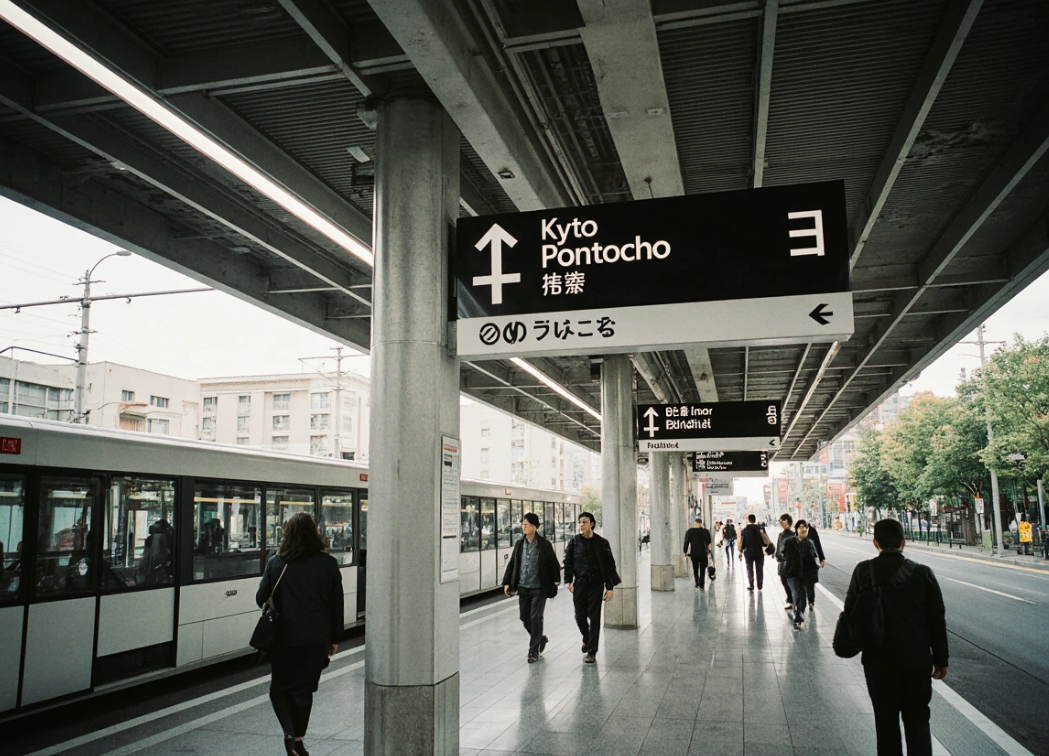Pontocho sits in downtown Kyoto, running parallel to the Kamo River between Shijo and Sanjo streets. You can reach this 500-meter alley from Kyoto Station in under 15 minutes by train or bus, with multiple stations within walking distance.
More about Pontocho:
Where Exactly Is Pontocho?
The alley occupies a strip of land between two rivers—Kamo to the east and Takase to the west. This narrow corridor stretches about 500 meters from Sanjo-dori in the north to Shijo-dori in the south. You’ll find it in Nakagyo Ward, right in Kyoto’s downtown heart.
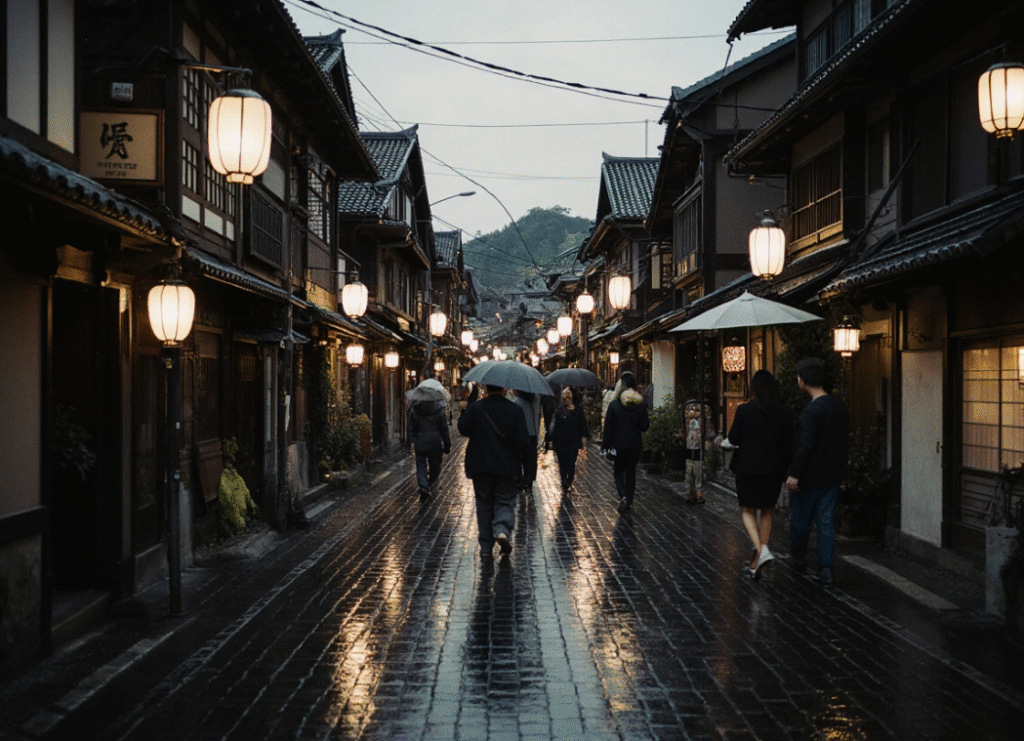
How to get to Pontocho from Kyoto Station – Evening Walk to Pontocho
The area emerged in 1670 when engineers reclaimed land from the Kamo River. They built embankments and created what would become one of Kyoto’s five main geisha districts. The name itself tells the story: “ponto” comes from Portuguese for “bridge,” while “cho” means “district” in Japanese.
Three train stations serve the area directly. Gion-Shijo Station on the Keihan Line sits across the river, just a 3-minute walk away. Hankyu Kawaramachi Station requires 5 minutes on foot. Sanjo Station, also on the Keihan Line, places you at the northern entrance in 5 minutes.
Getting There From Kyoto Station
The journey from Kyoto Station takes 10-15 minutes regardless of your chosen method.
By Train: The Fastest Route
Take the Karasuma Line subway to Shijo Station, then walk 10 minutes west along Shijo-dori to reach the destination. The train ride itself lasts about 2 minutes. The walk from Shijo Station cuts through downtown shopping streets lined with department stores and restaurants.
Alternatively, transfer at Karasuma-Oike Station from the Karasuma Line to the Tozai Line, heading toward Sanjo Keihan Station. This adds one transfer but drops you closer to the northern entrance.
Cost breakdown: A single ride on the Karasuma Line costs 220 yen ($1.50). The combined route with a transfer runs 290 yen ($2). With an IC card, you tap at the entrance gate and again when exiting—the system calculates your fare automatically.
By Bus: The Direct Option
Four bus lines connect Kyoto Station to the area: numbers 4, 5, 17, and 205. All stop at Shijo Kawaramachi, which sits just a 5-minute walk from the alley.
Board from the rear door at Kyoto Station’s bus terminal. Look for the green Kyoto City Bus at platforms A2 (line 4), A1 (line 5), or D2 (lines 17 and 205). The ride takes 10-11 minutes under normal traffic conditions but can stretch to 20 minutes during peak hours.
The flat fare within central Kyoto is 230 yen for adults and 120 yen for children under 12. Pay when exiting through the front door. Drop exact change into the fare box or tap your IC card on the reader.
Bus vs. Train: Buses cost 230 yen but face traffic delays. Trains cost 220-290 yen and run on fixed schedules every 5 minutes. Choose trains during morning rush (8-9 AM) and evening commute (5-7 PM). Buses work better when you want to see the city streets.
On Foot: The Scenic Path
Walking from Kyoto Station takes about 25 minutes. Exit through the station’s central gate and head north along Karasuma-dori. Turn right onto Shijo-dori at the fifth major intersection. Follow Shijo east for about 10 minutes until you cross a small canal—the entrance sits on your right.
The walk covers roughly 2 kilometers. You’ll pass Higashi Honganji Temple’s massive gates within 5 minutes of leaving the station. The route follows wide sidewalks with pedestrian signals at every crossing.
This option works when you arrive with small bags during mild weather. Skip it if you’re carrying luggage or visiting in July-August when temperatures hit 35°C (95°F) with 70% humidity.
By Taxi: When Comfort Matters
Taxis from Kyoto Station reach the destination in about 10 minutes, depending on traffic. The base fare starts at 680 yen for the first 1.2 kilometers, with the meter adding 80 yen per 300 meters after that.
Expect to pay 900-1,200 yen ($6-8) for the 2-kilometer trip under normal conditions. During rush hour, the meter keeps running while you sit in traffic, potentially pushing the cost to 1,500 yen ($10).
Find taxis at the designated stand outside Kyoto Station’s north central exit. Look for the yellow “TAXI” signs on the roof. Drivers rarely speak English, so have your destination written in Japanese: 先斗町 (Pontocho).
When taxis make sense: You’re traveling with three or more people (splitting the cost). You have luggage. You arrive late at night after bus service ends around 11 PM. You’re exhausted from a long journey.
Transportation Cost Comparison
| Method | Travel Time | Cost (per person) | Best For |
| Subway | 12 minutes | 220-290 yen ($1.50-2) | Speed, reliability |
| Bus | 10-20 minutes | 230 yen ($1.60) | Direct route, sightseeing |
| Walking | 25 minutes | Free | Exercise, exploring |
| Taxi | 10 minutes | 900-1,200 yen ($6-8) | Groups, luggage, comfort |
Pontocho Access Guide: Coming From Other Kyoto Stations
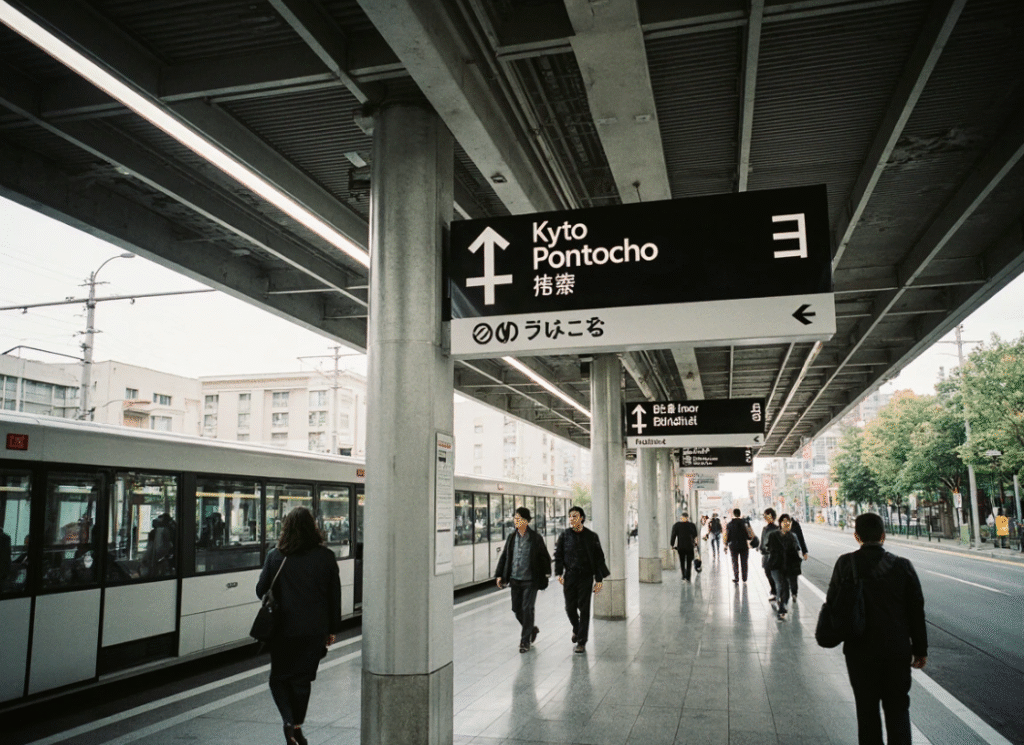
Pontocho Transport: Directions from Kyoto Station to Pontocho by Subway and Bus
From Arashiyama
The bamboo forest area in western Kyoto connects via the JR Sagano Line. Ride from Saga-Arashiyama Station to Kyoto Station (15 minutes, 240 yen), then follow any of the routes described above.
Direct bus option: Take bus 28 from Arashiyama toward Kawaramachi. Get off at Shijo Kawaramachi (35 minutes, 230 yen). This route saves money but takes longer.
From Fushimi Inari Shrine
The famous torii gate shrine sits on the Keihan Line. Board a train at Fushimi Inari Station and ride directly to Gion-Shijo Station—a 3-minute walk from the southern entrance. The journey takes 6 minutes and costs 210 yen.
This represents the easiest connection between two of Kyoto’s most popular sites. Trains run every 7-10 minutes throughout the day.
From Kinkaku-ji (Golden Pavilion)
No direct train serves Kinkaku-ji. Take bus 205 from the temple to Shijo Kawaramachi (30 minutes, 230 yen). The same bus continues to Kyoto Station if you need to drop luggage first.
Understanding Kyoto’s Bus System
Think of Kyoto buses like a grocery store loyalty card program. The first time you use it today, you pay full price. After that, you show your card and keep moving. That’s how day passes work—one initial payment unlocks unlimited rides.
Kyoto City Bus routes operate on a flat fare zone where adults pay 230 yen and children pay 120 yen within central Kyoto. Some routes leave this zone and charge distance-based fares, but all routes to the area stay within the flat zone.
- Boarding procedure: Enter through the rear door. If your route might leave the flat fare zone (rare for tourist areas), take a numbered ticket from the dispenser. Most riders skip this step for central Kyoto routes.
- Exiting: Press the stop button when you hear your stop announced. Exit through the front door. Insert your IC card into the reader or drop exact change into the fare box. The machine doesn’t give change, so you’ll need exact coins or bills.
- Change machine: Every bus has a coin changer next to the driver. It breaks 1,000-yen bills into coins but won’t accept larger denominations. Use this before your stop to avoid holding up other passengers.
IC Cards vs. Day Passes: Which Saves Money?
The math is simple. The Subway & Bus One-Day Pass costs 1,100 yen and covers unlimited rides on Kyoto City buses, Kyoto Bus, and both subway lines. A single bus ride costs 230 yen. Break-even happens after five rides in one day.
Your calculation: Count how many times you’ll ride buses or subways today. Five or more rides? Buy the day pass. Four or fewer? Use an IC card and pay per ride.
“Most tourists overestimate how much they’ll use buses. A typical day covers 3-4 major sites, meaning 6-8 bus rides. The day pass saves money only if you’re temple-hopping all day. For one or two destinations, IC cards cost less and you won’t feel pressured to ‘get your money’s worth’ by rushing between sites.”
How IC Cards Work
IC cards like ICOCA, Suica, and Pasmo work on all Kyoto City and Kyoto Buses. Buy one at any station ticket machine. The card itself costs 500 yen deposit (refundable) plus whatever amount you load—start with 2,000 yen.
Tap the card reader when entering train gates and when exiting buses. The machine displays your remaining balance. Reload at any station machine or convenience store with the IC card symbol.
Cards work throughout Japan. Your Tokyo Suica card functions in Kyoto. Your Kyoto ICOCA card works in Osaka, Tokyo, and even rural areas. One card covers your entire trip to Japan trip.
Kansai Airport to Pontocho: Two Main Options
Haruka Limited Express
The fastest route. The train reaches Kyoto Station in about 75 minutes. Trains depart every 30 minutes from early morning until late evening.
Regular fare: 3,600 yen ($24) for a reserved seat, 3,170 yen ($21) for unreserved. The ICOCA & Haruka discount package offers the train plus an ICOCA card loaded with 2,000 yen for 3,600 yen total—essentially a free train ride when you factor in the card value.
From Kyoto Station, follow the routes above (add 10-15 minutes).
Airport Limousine Bus
Buses run from KIX to Kyoto Station in about 85 minutes. They cost 2,800 yen ($19) and include luggage storage under the bus. Departures every 30-60 minutes depending on the time of day.
Choose the bus if you have heavy luggage or want to avoid train transfers. Choose the train for speed and frequency.
How Pontocho Became Kyoto’s Most Photographed Alley
Twenty years ago, the district drew mostly Japanese businessmen to its exclusive geisha tea houses. Restaurants required introductions. Foreigners rarely ventured down the narrow lane.
Instagram changed everything. Starting around 2015, travel bloggers posted photos of lantern-lit alleys and riverside dining terraces. The algorithm favored these images—narrow vertical frames perfect for phone screens, warm lighting, traditional architecture.
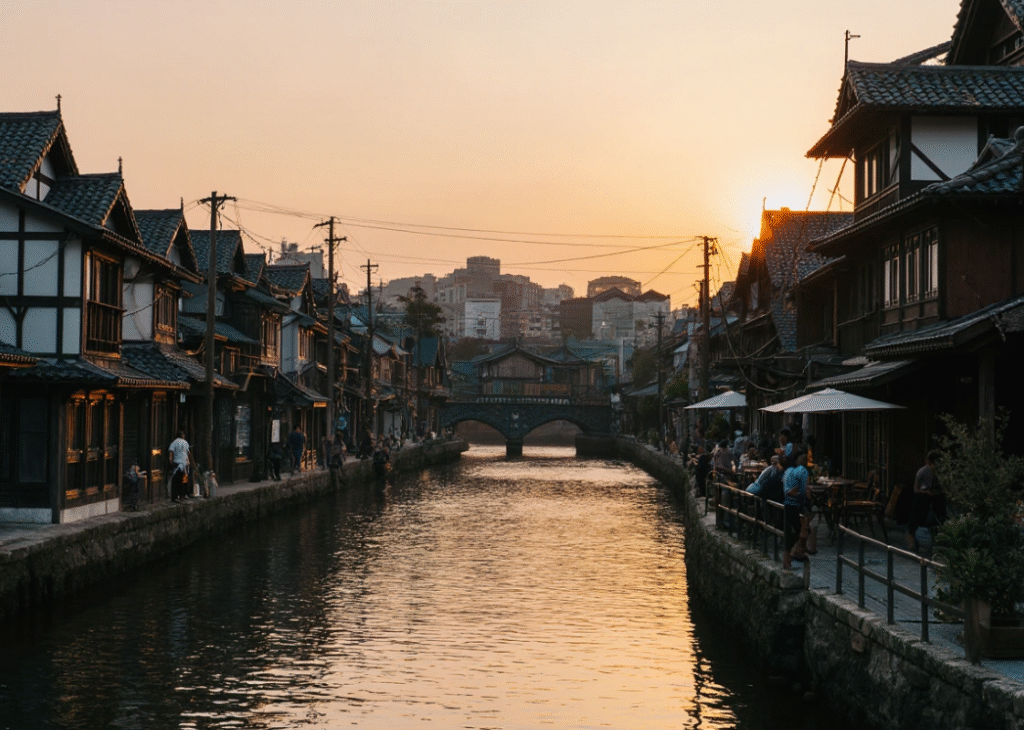
Pontocho Access Guide: Scenic View of Kamogawa River and Pontocho District
By 2019, the area appeared in “best of Kyoto” lists on every travel site. The district could have gone two ways: embrace tourism with English menus and open-door policies, or maintain exclusivity by raising prices and keeping reservation requirements.
It chose a middle path. High-end tea houses stayed exclusive. But a new category of restaurants emerged—mid-range places with English menus, Instagram-ready presentations, and friendly service. These restaurants filled the old wooden buildings between the exclusive establishments.
Today, half of the restaurants welcome walk-in foreign visitors. The other half operates on the traditional introduction system. Most establishments open from around 5 PM to 11 PM, though some serve lunch.
The alternative timeline: If Instagram had never existed, the area might resemble Miyagawa-cho—another geisha district two blocks south that receives 10% of the visitor traffic. It would preserve more tradition but offer fewer accessible experiences for international visitors.
This transformation affects your visit. You can now explore independently, photograph the alley (but not geisha), and dine at dozens of restaurants without reservations. But you’ll share the narrow lane with hundreds of other visitors between 6-9 PM on weekends.
Pontocho Directions: Navigating the Layout
The alley runs straight for 500 meters with no curves. Think of it as one long hallway with doors on both sides. Enter from either end—Shijo-dori (southern entrance) or Sanjo-dori (northern entrance).
- From the Pontocho bus stop name Shijo Kawaramachi, walk west one block toward the river. You’ll see a stone marker reading “Ponto-cho” in English. Turn right into the alley.
- From Gion-Shijo Station (Keihan Line), take Exit 4. Cross the Shijo Ohashi Bridge over the Kamo River. The southern entrance sits immediately on your left after crossing.
- From Kyoto-Kawaramachi Station (Hankyu), use Exit 1A. Walk east toward the river for 5 minutes along Shijo-dori. Turn left when you see the stone monument.
Width warning: The alley measures just 3-4 meters wide. Two-way foot traffic means constant sidling past other visitors during busy hours. Don’t bring rolling suitcases. Leave luggage at your hotel or use coin lockers at the station.
Side lanes branch off every 50 meters. These connect to Kiyamachi Street running parallel to the west. These passages provide escape routes when the main alley gets too crowded.
How to Walk From Kawaramachi Station to Pontocho
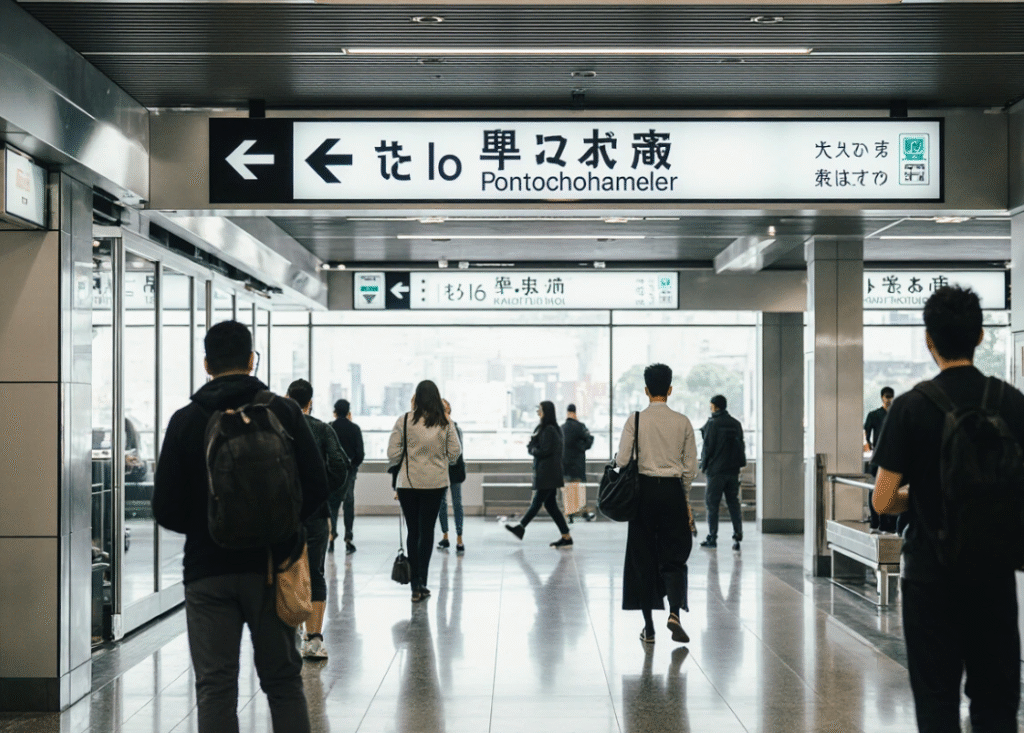
Exit Hankyu Kawaramachi Station through Exit 1A onto Shijo-dori. Turn left (east) and walk toward the Kamo River for approximately 5 minutes. You’ll pass several shops and restaurants along this busy pedestrian street. When you reach the river area, look for the stone monument marking the entrance on your left. The total walking distance is about 400 meters, making it easy to get to Pontocho from this station.
Three Common Mistakes (And Their Real Cost)
Mistake 1: Visiting Only During the Day
Tourists book afternoon visits because that’s when they’re exploring downtown Kyoto. The area appears in their schedule between Nishiki Market and Gion.
- Why people do this: Tour itineraries list it as a “sight” alongside temples and shrines. Visitors assume it operates all day like other attractions.
- Price of this mistake: The district is quiet during the day, almost sleepy, and comes alive at night. Most restaurants close for lunch. Lanterns remain unlit. The atmospheric quality disappears.
You waste 20-30 minutes traveling to a location that won’t deliver its promised experience. More importantly, you miss the actual spectacle—lanterns glowing at dusk, restaurants preparing for evening service, the possibility of spotting geisha heading to appointments.
- Cost in numbers: 30 minutes lost plus 460 yen round-trip transportation (230 yen each way). You’ll need to return at night anyway, doubling your costs. Total waste: 60 minutes and 920 yen, plus the disappointment of seeing empty, closed venues.
- The fix: Schedule your visit for evening hours between 5-9 PM. Combine it with nearby Gion, which looks best at dusk. Use daytime for temples that require natural light for photography.
Mistake 2: Eating at the First Restaurant You See
You enter from the southern entrance and immediately see restaurants with English menus and illuminated signs. One looks good enough, so you stop and eat within the first 100 meters.
- Why people do this: Decision fatigue after a long day of sightseeing. The visible English menus provide comfort. The first restaurants specifically position themselves to catch hungry visitors entering from the popular Shijo entrance.
- Price of this mistake: The best restaurants—both in terms of value and quality—scatter throughout the alley. Restaurants along the eastern side overlook the Kamo River. From May to September, these places build temporary platforms called “kawayuka” over the water.
By eating at the first option, you miss river views, better food-to-price ratios, and the unique seasonal dining experience. The entrance restaurants know visitors won’t walk the full length of the alley, so they charge premium prices for average food.
- Cost in numbers: A meal at entrance restaurants averages 4,000-6,000 yen ($27-40) per person. Walk 300 meters farther, and comparable meals cost 2,500-4,000 yen ($17-27). On a two-person dinner, that’s a 4,000 yen ($27) difference for the exact same type of food. Plus you lose the river view and summer terrace experience.
- The fix: Walk the entire alley once before choosing. It takes 10 minutes. Check which restaurants have river views and summer terraces. Compare menu prices at 3-4 places. Then backtrack to your preferred choice. The investment of 10 minutes saves 2,000+ yen per person and vastly improves your experience.
Mistake 3: Bringing Large Bags or Luggage
Travelers combine their visit with their arrival or departure day. They drag suitcases from Kyoto Station, planning to grab dinner before heading to their hotel or catching a train.
- Why people do this: Efficient time management. Why make an extra trip when you can visit on the way to somewhere else? The bags aren’t that big. It should be fine.
- Price of this mistake: The area is characterized by narrow, stone-paved alleys with many people walking around. Most restaurants are small, making it difficult to bring in large luggage.
The alley narrows to 3 meters in sections. You’ll constantly block other pedestrians while maneuvering your bag. Restaurants won’t seat you with large luggage—no storage space exists in tiny traditional buildings. You’ll either stand outside guarding your bags while companions eat, or abandon your plans entirely.
Cost in numbers: Coin lockers at Kyoto Station cost 400-700 yen ($3-5) depending on size. Station storage services charge 800 yen per bag. These options feel like unnecessary expenses.
Instead, you spend 30 minutes awkwardly navigating with luggage. Other visitors glare. Restaurant hosts turn you away. You eventually retreat to Kyoto Station, store your bags in lockers anyway (same 400-700 yen cost), then return—adding 30 minutes each way in transit (60 minutes total) and 460 yen in extra bus fare.
- Total waste: 90 minutes, 460 yen in extra transport, plus the stress and embarrassment of blocking narrow walkways with luggage. The cost of avoiding the 400-yen locker at the start: 90 minutes and 460 yen. You lose 90 minutes and spend 460 yen to avoid spending 400 yen.
- The fix: Store all bags larger than a daypack at Kyoto Station or your hotel before visiting. The small upfront cost prevents massive time waste and guarantees you can actually enter restaurants.
Is It Easy to Get to Pontocho?
Yes, reaching the district is straightforward and convenient. Multiple public transport options—subway, bus, and taxi—operate frequently throughout the day. The closest station to Pontocho (Gion-Shijo on the Keihan Line) sits just 3 minutes away on foot, while Hankyu Kawaramachi and Keihan Sanjo stations are both within 5 minutes walking distance. Clear signage in English helps visitors navigate, and the compact downtown layout means you’re never far from alternative transportation methods if needed.
What Is the Closest Subway Station to Pontocho?
While technically not a subway station, Gion-Shijo Station on the Keihan Line is the nearest train stop at just 3 minutes walking distance. For actual subway connections, Kyoto-Shijo Station on the Karasuma subway line requires a 10-minute walk. Most visitors find the Keihan stations (Gion-Shijo and Sanjo Keihan Station) more convenient due to their proximity and direct access to the alley’s entrances.
For Whom the District May Disappoint
This isn’t the authentic geisha experience you saw in documentaries. The area is packed with restaurants on both sides offering a wide range from inexpensive yakitori to highly exclusive establishments requiring the right connections.
Skip the area if you:
- Expect quiet, traditional Japan: Peak evening hours (6-9 PM Thursday-Saturday) bring crowds of hundreds. The alley feels like a theme park corridor. Conversation noise echoes off the narrow walls. It’s atmospheric, but not serene.
- Seek authentic geisha culture: True geisha entertainment happens behind closed doors in tea houses that require introductions and charge $500+ per person. You might spot a geisha walking to an appointment, but that’s the extent of the experience for most visitors. Photographing geisha is prohibited and considered extremely rude.
- Prefer modern comfort: These are old wooden buildings. Stairs are steep. Bathrooms are tiny. Air conditioning struggles in summer. Heating feels inadequate in winter. If you need fully accessible facilities or modern amenities, choose restaurants in newer parts of Kyoto.
If you accept the district as a beautiful, touristic dining area rather than a window into ancient Japan, you’ll love it. The lanterns genuinely glow beautifully. The alley’s proportions create perfect photographs. The food quality ranges from good to excellent. The riverside dining in summer offers a unique experience you won’t find elsewhere.
Adjust expectations. You’re visiting a historic entertainment district that successfully adapted to tourism while maintaining aesthetic charm. That’s different from “undiscovered Japan,” but it’s still worth experiencing.
Best Times to Visit
- Weekday evenings (Tuesday-Thursday, 5-7 PM): Moderate crowds. Restaurants are still setting up, so you can browse menus without feeling rushed. Easier to score a window seat overlooking the river.
- Weekend evenings (Friday-Saturday, 6-9 PM): Peak crowds. Expect waits at popular restaurants. The alley itself gets congested. But this is also when the energy peaks—locals mixing with tourists, every restaurant operating at full capacity, the complete sensory experience.
- Late night (9-11 PM): Crowds thin out. Many restaurants start closing, but bars remain open. You’ll find cheaper drink deals and a more relaxed atmosphere. Better for photography with fewer people in your shots.
- Summer (May-September): Many restaurants build temporary platforms over the Kamo River where patrons can dine in the open air, a tradition dating back to the late 1500s. Called “kawayuka,” these elevated terraces provide the most unique experience. Book riverside restaurants in advance during this season.
- Winter (December-February): The stone streets look beautiful with occasional snow. Fewer tourists mean easier restaurant access. The downside: river views matter less, and cold weather makes the narrow alley feel cramped when everyone’s bundled in heavy coats.
What’s Nearby: Maximizing Your Trip
Don’t visit in isolation. The area concentrates several of Kyoto’s best downtown attractions within walking distance.
- Nishiki Market (10-minute walk west): Kyoto’s food market spanning five blocks. Open 10 AM-6 PM daily. Sample local specialties, buy pickles and sweets, watch artisans prepare traditional foods. Combine with morning/afternoon sightseeing, then return for dinner.
- Gion District (5-minute walk east, across the river): Kyoto’s most famous geisha district. Walk Hanami-koji Street to see traditional tea houses and shops. Better preserved with wider streets and less tourist infrastructure. Visit at dusk for the best atmospheric lighting.
- Kamo River Path (immediate access): The walking path along the Kamo River provides peaceful breaks from crowded streets. Locals gather here for picnics, studying, and people-watching. In summer, couples sit on the river banks in evenly spaced pairs—a Kyoto phenomenon that makes for interesting photography.
- Kawaramachi Shopping District (3-minute walk west): Modern shopping street with department stores, bookshops, and restaurants. Useful for last-minute purchases, rainy-day plans, or finding familiar chain restaurants if you need a break from traditional food.
A Different Perspective: Why I Keep Returning
I’ve walked the alley dozens of times over eight years of living in Kyoto. The first visit excited me—narrow lanes, glowing lanterns, the promise of spotting geisha. But that excitement came from novelty.
What keeps me returning isn’t the Instagram-famous views. It’s how the alley functions as a neighborhood despite the tourists. The restaurant owners recognize regulars. In the side streets, locals park bicycles and hang laundry. Early mornings (before 10 AM), you’ll see staff sweeping storefronts and prepping ingredients.
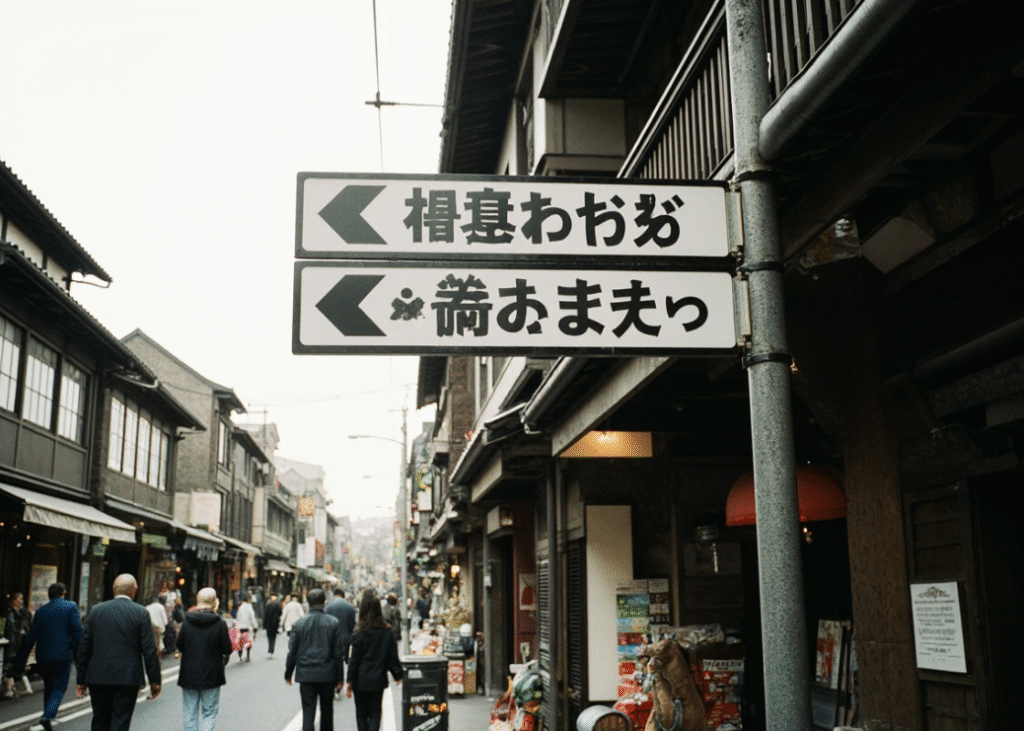
How to Walk to Pontocho: Street Signs and Directions from Kyoto City
The mistake most visitors make isn’t about Pontocho transport or timing. It’s treating the area as a location to photograph rather than a place to spend time. The good restaurants here don’t just serve food—they create moments. Sitting on a riverside platform in summer, watching the Kamo River flow below, hearing the quiet conversation of other diners, feeling the city’s humidity break as the sun sets.
That experience requires slowing down. It requires booking a 7 PM reservation and staying until 9 PM. It requires ordering more drinks than you planned and lingering over dessert. The transportation to reach the destination matters very little. What matters is whether you’ll give the place enough time to work its small magic.
The best compliment I can give: it delivers on its promises when you let it. Getting there takes 10-15 minutes from anywhere in central Kyoto. The hard part is staying long enough to see why it matters.
Taxi Fare to Pontocho: What to Expect
From Kyoto Station, expect taxi fares between 900-1,200 yen ($6-8) under normal traffic conditions. The meter starts at 680 yen for the first 1.2 kilometers, then adds 80 yen per 300 meters. Rush hour traffic can push costs to 1,500 yen ($10) as the meter continues running. From Kansai Airport (KIX), taxi fares range from 15,000-18,000 yen ($100-120), making trains and buses far more economical for airport transfers. Within downtown Kyoto, most taxi trips stay under 1,500 yen.
Transportation at a Glance
- From Kyoto Station: 10-15 minutes by train (220-290 yen) or bus (230 yen)
- From Fushimi Inari: 6 minutes by train (210 yen)
- From Arashiyama: 50 minutes by train+transfer (470 yen total)
- Nearest stations: Gion-Shijo (3 min walk), Kawaramachi (5 min walk), Sanjo (5 min walk)
- Day pass value: Worth it if you’re taking 5+ rides in one day (1,100 yen)
- IC cards: Work on all buses and trains, reload at any station
